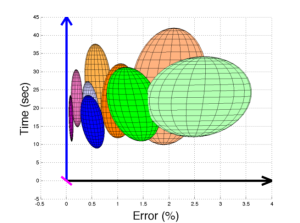Comparison and Evaluation of Sonification Strategies for Guidance Tasks


Authors: Parseihian G., Gondre C., Aramaki M., Ystad S., Kronland-Martinet R.
Publication Date: April 2016
Journal: IEEE Transactions on Multimedia (vol. 18 (4), pp. 674-686, 2016)
Abstract
This article aims to reveal the efficiency of sonification strategies in terms of rapidity, precision and overshooting in the case of a one-dimensional guidance task. The sonification strategies are based on the four main perceptual attributes of a sound (i.e. pitch, loudness, duration/tempo and timbre) and classified with respect to the presence or not of one or several auditory references. Perceptual evaluations are used to display the strategies in a precision/rapidity space and enable prediction of user behavior for a chosen sonification strategy. The evaluation of sonification strategies constitutes a first step toward general guidelines for sound design in interactive multimedia systems that involve guidance issues.
Video demonstration
For each strategy, you can ear the sound while observing the user (red point) searching the target.
A- Basic strategies
Pitch
Strategy based on pitch variations of the sound. The closer the target, the lower the sound frequency.
Tempo
Strategy based on tempo variations of the sound.The closer the target, the faster the sound repetition.
Loudness
Strategy based on loudness variations of the sound.The closer the target, the lower the sound level.
Brightness
Strategy based on brightness variations of the sound. The closer the target, the matter the sound.
B- Strategies with reference
Inharmonicity
Strategy based on sound harmonicity.The closer the target, the more consonant the sound.
Fluctuation Strengh
Strategy based on beating frequency.The closer the target, the slower the beatings.
Synchronicity
Strategy based on synchronicity between two sounds.The closer the target, the more synchronized the sound.
C- Strategies with reference and zoom effect
Multi Band Frequency Modulation
Strategy based on beating frequency.The closer the target, the slower the beatings.
Multi Scale Beating
Strategy based on beating frequency.The closer the target, the slower the beatings.
Results: Sonification efficiency 3D space

This figure represents the projection of the nine strategies in an error/time and oscillation space an user needs to precisely find the target. Each ellipsoid represents the error distribution along these three axis. For a sake of readability all ellipsoid have been reduced by a factor 4. Thus, this figure doesn’t give the exact distribution of the results, but helps to understand their repartition and the differences between the strategies.
